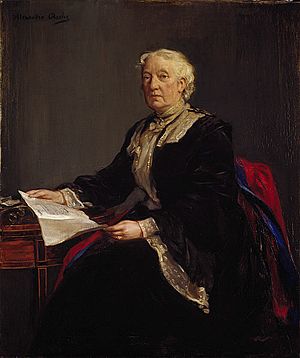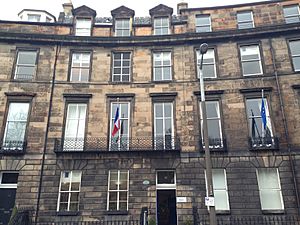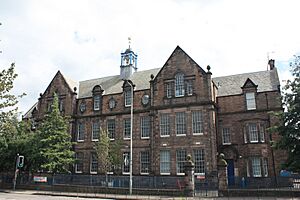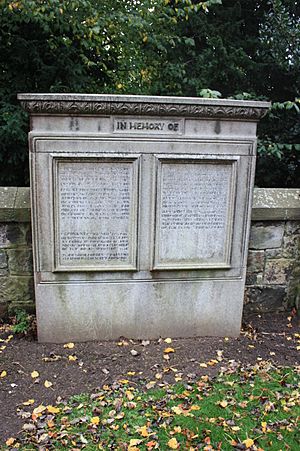Flora Stevenson facts for kids
Quick facts for kids
Flora Stevenson
|
|
|---|---|

Flora Stevenson with her red LLD gown, 1904 by Alexander Ignatius Roche
|
|
| Born | 30 October 1839 Glasgow, Scotland, UK
|
| Died | 28 September 1905 (aged 65) |
| Burial place | Dean Cemetery, Edinburgh |
| Nationality | [British] |
| Known for | campaigner for women's and girls' education one of the first two Scottish women to be elected to a School Board Flora Stevenson Primary School, Edinburgh is named for her |
Flora Clift Stevenson (born October 30, 1839 – died September 28, 1905) was an important British social reformer. She cared deeply about education for children, especially those who were poor or neglected. She also worked hard to make sure girls could get a good education and that women could go to university. Flora Stevenson was one of the very first women in the United Kingdom to be chosen to be part of a school board.
Contents
Flora's Early Life and Family (1839-1869)
Flora Stevenson was born in Glasgow, Scotland. She was the youngest daughter of James Stevenson, a merchant, and Jane Stewart Shannan. Flora grew up in a big family. Her sister, Louisa Stevenson, also became a famous campaigner for social change. Her brother, J. J. Stevenson, became an architect, and another brother, James Cochran Stevenson, became a Member of Parliament.
In 1844, when Flora was five, her family moved to Jarrow because her father started a new business. Later, in 1854, after her father retired, the family moved to Edinburgh. They settled into a house at 13 Randolph Crescent in 1859. Flora and her sisters, Louisa, Elisa, and Jane, lived there for the rest of their lives. A special plaque is now on the house, honoring these "women of achievement."
Helping Children and Education
Flora Stevenson's first project to help others was teaching reading and writing to young "messenger girls" in her own home at night. She was very active in groups that worked to improve the lives of poor people in Edinburgh. She also helped organize education in "ragged schools." These were special schools for some of the city's most neglected and poor children.
Flora and her sister Louisa were also involved in a big movement to allow women to attend university. They were part of the Edinburgh Ladies' Educational Association. This group helped women get access to university-level lectures, which was a huge step forward at the time.
Working on the School Board
A new law in 1872, called the Education (Scotland) Act, made it possible for women to join School Boards. These boards were in charge of local schools. Flora's friend, Henry Kingsley, told her she would be perfect for this role. She was one of the first two women ever elected to a school board in Scotland, alongside Phoebe Blyth. Flora stayed on the board for her entire life and eventually became its leader.
Because she had worked with the poorest children, Flora immediately started a plan to help them. She offered food and clothing to children if they promised to attend school regularly. She led the attendance committee for many years. She even shared her ideas about school attendance with a special government committee in 1887.
Flora strongly believed that "industrial schools" were important for children who had gotten into trouble. Her efforts led to the creation of a new type of industrial school in Edinburgh. This school was different because children attended during the day and then went home, instead of living there. In the 1890s, she helped create new laws and committees related to young offenders and schools.
Supporting Girls' Education
Flora Stevenson was a strong supporter of good education for girls. She thought it was unfair that girls in Edinburgh schools spent five hours a week on needlework while boys were having other lessons. Even though she promoted the Edinburgh School of Cookery and Domestic Economy, which taught cooking and home skills, she also believed in a balanced education. She once told a newspaper, "Girls should definitely be trained to be good 'housemothers,' but remember that a family's well-being depends equally on the 'housefather.'" She also served as a director for the Royal Blind School.
Flora also supported women's right to vote, known as suffrage. She believed that making sure children attended school was key to improving the lives of children who were struggling. However, she did not support free school meals, believing that parents should be responsible for food, with charities helping when needed. She often gave talks about education, and her ideas were usually well-received. She was also a leader in groups that supported free trade and the Women's Liberal Unionist Association.
Flora was involved in many other social projects and charities. She and her sister Louisa even paid for their niece, Alice Stewart Ker, to study medicine in Switzerland. Alice later became one of the first female doctors in Britain.
Honors and Final Years
In 1899, a new school in Edinburgh was named after her. Today, it is still known as the Flora Stevenson Primary School and includes the early years of the City of Edinburgh Music School. In her last few years, Flora received more honors. In 1903, she received an honorary degree from the University of Edinburgh. In 1904, a portrait of her was painted by Alexander Ignatius Roche, paid for by public donations. In 1905, she was given the freedom of the City of Edinburgh, a very special honor. She spent her final years at her home at 13 Randolph Crescent.
Flora became ill and had an operation in St Andrews, but it did not help. She passed away there in her hotel on September 28, 1905. Her body was brought back to Edinburgh for a funeral service and burial at the Dean Cemetery on September 30. Many people came to mourn her, including thousands of schoolchildren who lined the streets.
Her grave is located on the southern wall of the cemetery. Her sisters and mother are buried with her, and her father is buried nearby.
In 2021, the Royal Bank of Scotland honored Flora Stevenson by featuring her on a new £50 banknote.
See also
 In Spanish: Flora Stevenson para niños
In Spanish: Flora Stevenson para niños




